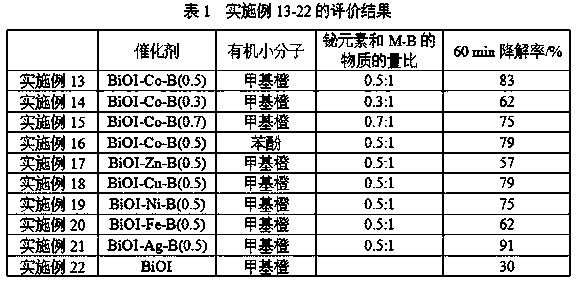A bioi-m-b synergistic photocatalyst for photocatalytic degradation of small organic molecules and its preparation method and application
A photocatalyst and small molecule technology, applied in the field of photocatalysis, can solve the problems of easy photocorrosion and easy decomposition, and achieve good stability and industrial application prospects
- Summary
- Abstract
- Description
- Claims
- Application Information
AI Technical Summary
Problems solved by technology
Method used
Image
Examples
Embodiment 1
[0022] A BiOI-M-B synergistic photocatalyst for photocatalytic degradation of small organic molecules, consisting of BiOI and M-B components, BiOI uniformly dispersed on the surface of the M-B amorphous alloy catalyst, where M is Co, Zn, Cu, Ni Any one element in , Fe and Ag; the ratio of the amount of substances of BiOI and M-B is 0.3-0.7.
[0023] The preparation method of the above-mentioned BiOI-M-B synergistic photocatalyst for photocatalytic degradation of small organic molecules, the specific steps are as follows:
[0024] (1) Preparation of amorphous alloy M-B: the soluble salt of M element reacts with sodium borohydride to form M-B amorphous alloy catalyst;
[0025] (2) Preparation of BiOI-M-B synergistic photocatalyst: BiOI-M-B synergistic photocatalyst was generated under acidic conditions by bismuth nitrate, NaI, amorphous alloy catalyst M-B and polyvinylpyrrolidone.
[0026] Step (1) is as follows: take the soluble salt of M element, dissolve it with distilled wa...
Embodiment 2
[0035] (1) Take Co(NO 3 ) 2 ·6H 2O, dissolve in distilled water, put the prepared cobalt nitrate solution in a constant temperature water bath at 25°C for later use; take sodium borohydride, dissolve it in distilled water, pour the prepared sodium borohydride solution into the dropping funnel, and add it dropwise In the above cobalt nitrate solution, the whole process was continuously stirred, after the dropwise addition was completed, suction filtered, the obtained solid was put into an oven, and dried at 60° C. for 2 hours to obtain the Co-B amorphous alloy catalyst.
[0036] (2) Take NaI, dissolve it in distilled water for later use; take bismuth nitrate pentahydrate in a three-necked flask, and then add 3M HNO 3 and the amorphous alloy catalyst Co-B prepared in step (1), add distilled water to dissolve and stir, then add the weighed polyvinylpyrrolidone, and adjust the solution in the three-necked flask to pH=2 with 1M NaOH; The flask is placed in an oil bath, and the t...
Embodiment 3
[0040] (1) Take Co(NO 3 ) 2 ·6H 2 O, dissolve in distilled water, put the prepared cobalt nitrate solution in a constant temperature water bath at 26°C for later use; take sodium borohydride, dissolve it in distilled water, pour the prepared sodium borohydride solution into the dropping funnel, and add it dropwise In the above cobalt nitrate solution, the whole process was continuously stirred, and after the dropwise addition was completed, suction filtered, and the obtained solid was put into an oven, and dried at 62°C for 2.2 hours to obtain the Co-B amorphous alloy catalyst.
[0041] (2) Take NaI, dissolve it in distilled water for later use; take bismuth nitrate pentahydrate in a three-necked flask, and then add 3M HNO 3 and the amorphous alloy catalyst Co-B prepared in step (1), add distilled water to dissolve and stir, then add the weighed polyvinylpyrrolidone, and adjust the solution in the three-necked flask to pH=2.1 with 1M NaOH; The flask is placed in an oil bath...
PUM
 Login to View More
Login to View More Abstract
Description
Claims
Application Information
 Login to View More
Login to View More - R&D
- Intellectual Property
- Life Sciences
- Materials
- Tech Scout
- Unparalleled Data Quality
- Higher Quality Content
- 60% Fewer Hallucinations
Browse by: Latest US Patents, China's latest patents, Technical Efficacy Thesaurus, Application Domain, Technology Topic, Popular Technical Reports.
© 2025 PatSnap. All rights reserved.Legal|Privacy policy|Modern Slavery Act Transparency Statement|Sitemap|About US| Contact US: help@patsnap.com


